|
Main Course
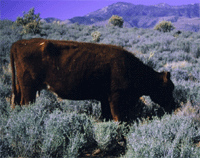
The terrain in Utah (above) creates a much different cow than those in Louisiana |
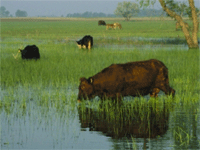
|
Origins of Preference
While we are used to considering forage type, nutrition and quantity as we try to improve animal health and increase weight gain, we sometimes overlook how an animal's interactions with it's mother and peers affect what and how it eats. Since what a young animal learns has life-long consequences, knowing more about this process can help us be more successful managers.
A young animal learns what kind of things it should eat and do from its herd or "social group." This explains how animals of the same species can survive in extremely different environments. For example, a calf reared in the sage-covered deserts of southern Utah and one raised on grass in the bayous of Lousiana have completely different diets and habits. This same flexibility occurs for humans as psychologist Paul Rozin points out: "Consider the massive differences between the almost purely carnivorous diet of Eskimos and the plant-dominated diets of many tropical cultures, or between the elaborate cuisines of India or France and the relatively limited amounts of food processing carried out by some hunter-gatherers."
Next - Listen to Your Mother!
Mother Knows Best

Download Mother Knows Best Fact Sheet |
Mom has the greatest influence on an animal’s food and habitat preferences. After all, she's been successful enough at foraging to grow up and reproduce. For young herbivores paying attention to mother is crucial for learning where and where not to go and what and what not to eat. Through interactions with mother, young animals learn about their surroundings, from the whereabouts of water, shade, cover, and predators, to the kinds and locations of nutritious and toxic foods.
As offspring begin to forage, they learn quickly to eat foods mother eats, and they remember those foods for years. Research shows that lambs fed nutritious foods with their mothers for 1 hour per day for 5 days eat more wheat than lambs exposed to wheat without their mothers. Even 3 years later, with no additional experience with wheat, those who had eaten wheat with their mothers ate 10 times more than lambs who first tasted it alone.
Research also shows that a mother can reduce her offspring's risk of eating toxic foods. If a mother avoids harmful foods and selects nutritious alternatives, the lamb acquires preferences for foods its mother eats and avoids foods its mother avoids. When lambs were given a choice between two foods, one of which their mother was trained to avoid, the lambs showed a preference for the one they had eaten with their mother. Thus, Mom models the behavior her offspring will later choose.
Next - Learning to eat with chopsticks (the animal version)
Foraging Skills
In the process of foraging with mother, young animals also learn the skills they need to make meals of the different kinds of foods they encounter. Just as you learned how to eat corn on the cob or tacos, a young animal must develop different techniques for grasses, leafy plants and shrubs.
The rate at which goats and sheep are able to consume grasses and shrubs increases with experience. In the study shown at right, bite rates nearly doubled as experience increased from no experience to 30 days of browsing blackbrush shrubs. Younger animals 6 months of age learned foraging skills more readily than older animals 18 months of age.

Click to watch an experienced goat eating blackbrush
|
The young goat shown in the appetizer video was trying to eat blackbrush for the first time. You can see the difference experience makes in this vide. His herd mate was experienced at biting off blackbrush stems and leaves.
Next - Where should I live?
Habitat Selection
Both livestock and wildlife inhabit specific areas in the environment called home ranges, areas they tend to occupy year after year. Interactions with mother influence the home ranges of offspring.
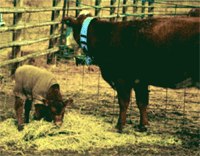
This cross-fostered calf preferred his new mother's home range to that of his birth mother.
|
In one study, Welsh Mountain sheep preferred native range while Clun sheep preferred seeded range. Lambs from Welsh Mountain sheep were grafted onto Clun sheep and vice versa. After weaning, the Clun lambs preferred native ranges, whereas the Welsh Mountain lambs preferred seeded ranges. The same has been shown for cattle on rangelands.
Animals may stray from home ranges because of interactions with peers, or due to a lack of water or food in times of drought or fire. When conditions improve, they generally return to their home ranges. For example, when water sources dry up, cows may travel to find a new water source, increasing the size of their home range. When rains or snow refill old water sources, the cows are likely to return to their original range.
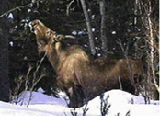 |
Wild herbivores also learn habitat preferences from their mothers. In some cases, home range fidelity is so strong that offspring actually use poorer quality habitats as a result of experiences with mother. For instance, each fall a herd of moose in central Norway migrates to high-elevation winter ranges, rather than follow normal migratory patterns to the lowlands. Archeological evidence indicates this has been occurring for the past 5,000 years. The moose evidently began this migration pattern because of hunting pressure. This behavior continues despite lower-than-normal calf production of the herd due to poor winter range conditions, demonstrating the persistence of learned habits.
Next - But Mom, everyone else is doing it!
Peer Influence
Other animals, young and old, can also influence diet and habitat selection. When mother is not available, lambs can learn from other older ewes. For example, lambs exposed to barley with their mothers ate 40% more than lambs exposed to barely with an adult female from the flock. However, eating barley with any ewe dramatically improved consumption by lambs compared to lambs exposed to barley alone.
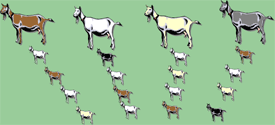 While goats started with very different diets, the diets of subsequent generations became more and more similar. While goats started with very different diets, the diets of subsequent generations became more and more similar. |
An animal can learn to eat new foods if it sees other animals eating foods it is unfamiliar with, though younger animals are much more likely to change, than older animals. As an example, in one study, 4 groups of goats reared on 4 different farms were placed on a common pasture with a variety of plants. Goats from the same farm ate similar plants, but each farm's goats ate a different selection of plants. The food preferences of the mothers did not change over the next four years. However, as the offspring interacted, they began to eat more similar diets. During the four year life of the study, researchers found that the diets of offspring became more and more similar. In addition, although kids selected different diets than their mothers, it was still possible to track which kid's mother came from which farm based on a noticeable preference for specific plants
Next - Because we've ALWAYS done it this way!
Early Experience Makes the Difference
Experiences early in life affect intake of both poor quality and good quality foods. This was demonstrated by a study at Utah State University on intake of blackbrush by goats. Blackbrush grows in the transition zone between the hot and cold deserts. It is very low in protein and digestibility. One group of goat kids was exposed to blackbrush with their mothers from the time they were 1 month old until they were 4 months old. Another group of kids was not exposed to blackbrush until they were 4 months old, and they were not exposed with their mothers.
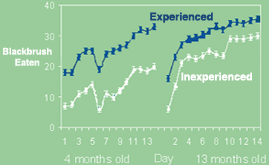 |
The intake of four-month old kids exposed to blackbrush with their mothers was compared to the intake of four-month old kids with no exposure was compared. Those who were exposed early and with their mothers ate more blackbrush than kids with no exposure. The difference even remained later in life at 13 months of age as shown in the graph at right. Early exposure also affected preference for blackbrush. Even when 13 month-old-goats had alfalfa pellets free choice, those that had been exposed to blackbrush early in life ate 30% more blackbrush than goats that had not been exposed to blackbrush until later in life.

Check out this Fact Sheet! "Structure Determines Experience" |
While working on a similar project, researchers noted another important aspect of experience. One group of goats came from Arizona where they were used to being herded and eating grass. After 3 months they had hardly moved from the fenceline. Thanks to their poor foraging they lost about 16% of their inital weight. In contrast, a group of semi-feral goats from the brush-dominated rangelands of South Texas disappeared into the brush immediately and were seldom seen all winter long. They foraged throughout the pastures and lost only 5% of their body weight during the winter. Both animals were of the same species - goat - but their previous experiences made them different creatures. The same is true for other wild and domestic grazers.
Next - What to do when you're new to the neighborhood
How Animals Handle Unfamiliar Environments
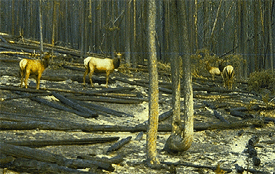
Elk looking for food in a new, post-fire environment |
Think for a moment how you react when you visit a new place. Are you disoriented and maybe even a little frightened? Do you prefer to go to new places with friends or alone? How do you choose where to eat? Do you ask someone local or do you settle for something familiar like McDonald's, even if you don't like the food?
When moved to a new location, or when their environment changes due to fires or floods, livestock and other animals face many of the same challenges we do. In fact, a new environment is generally much harder on livestock than on people because animals don't have the luxury of fast food chains, road maps, or signs. Much of the knowledge animals have from their old environment may be useless or even detrimental in the new one. Animals suffer more from malnutrition because of a lack of familiar foods. They may eat poisonous plants because they often choose familiar toxic foods over unfamiliar foods. There is also evidence that the same dose of a toxin has a much greater effect in an unfamiliar environment so the eating the same amount of a toxic food they could have in a familiar environment may be lethal. This may be because stress inhibits immune responses, increasing illnesses and decreasing performance.
 Click here for stories of dangers to animals in new environments. Click here for stories of dangers to animals in new environments. |
Based on an understanding of how animals learn, what can you do to ease transitions, increase animal performance on new foods, and make your operation more productive?
Next - In Conclusion: Key Points to Take With You From This Meal
Conclusion: Key Points to Take With You From This Meal
Mother Knows Best. Young animals learn best from Mom. They learn about what to eat, where to go, and how to behave. She also teaches them the skills they need to eat a wide variety of forages.
Early learning lasts longest. What a mother teaches her young remains with them throughout their lives. They may even choose poorer forages and habitats as a result of their early experiences.
But everyone else is doing it! When Mom is not available, older animals are a good substitute. Animals also learn from their peers. Learning continues throughout life, but younger animals are more likely to try new things than older animals.
Structure creates experience and experience creates structure. Because of differences in early experiences, animals of the same species may have widely different food and habitat preferences and foraging skills.
There's no place like home. When animals are moved to unfamiliar places they experience stress demonstrated as a loss of weight, increased illness, or susceptibility to predators. Their old habits may not apply to their new environment. By remembering that animals choose what to eat and where to go based on past experience, we can ease transition to new sites.
Dessert
Try These Things at Home To Make Your Bottom-Line Bigger!
You can use the fact that animals learn quickly and effectively from mother and one another to reduce costs and increase productivity in a variety of ways. Here are just a few examples:
What is learned in the cradle lasts to the grave.
Old Saying |
1. Early Training Improves Transitions
Expose young animals to food they will need to eat later in life such as grains they might encounter at a feedlot, and poor-quality foods you might feed during the winter or that they will find on the range. Young animals need to get used to the flavor and acquire the skills to eat new foods. Animals with early experience with foods are less likely to become ill and are more likely to gain weight and maintain productivity when they encounter foods in new environments.
Be aware of the effects that toxins can have on an animal's willingness to eat some foods. Read more about this in Palatability is More Than a Matter of Taste.
2. When it Comes to Replacements - Handsome Is As Handsome Does
Keep replacement animals whose mother have desirable habits. Don't keep heifers, no matter how good-looking they may be, if their mothers eat the wrong foods or graze in the wrong places.
Price and good looks are only part of the equation when it comes to purchasing replacements. If you want animals to graze, don't buy replacements who were raised on harvested forage or in dry lot. Buy replacements from areas with vegetation similar to that on your home place.
3. There's No Place Like Home
Be careful where you raise your replacements. If you have an opportunity to lease grazing land at a cheap price but it's vey different from your home place, you may want to leave your replacements and their mothers at home. This ensures that they will learn to live and eat in the environment where they will spend the most time.
|

